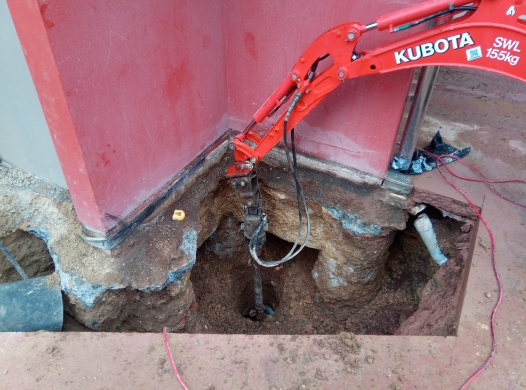Forensic Engineers can help you.
Underpinning explained
Underpinning techniques in the construction and maintenance of buildings and other structures are vital, especially when addressing foundation issues. It involves supporting the footings to stabilise the structure.
Whether you are dealing with subsidence, foundation failure, or planning significant renovations, understanding underpinning and its benefits can help you make informed decisions. Here’s why you might need an underpinning report, what we check for, and the possible implications for your property.

Why You Need an Underpinning Report
If you notice signs of foundation issues or plan major structural changes, an underpinning report can be essential. Here are some reasons why you might need an underpinning report:
- Visible Cracks in Walls and Floors: Large cracks, especially those that appear suddenly or grow over time, can indicate foundation soil movements. An underpinning report can determine if underpinning is necessary to stabilise the structure.
- Subsidence Issues: If your property is affected by subsidence, underpinning might be required to prevent further sinking and to restore stability.
- Doors and Windows Misalignment: When doors and windows start sticking or fail to close properly, it might be due to foundation movement. An underpinning assessment can help identify and address the root cause.
- Planning Extensions or Renovations: Significant changes to the structure, such as adding new floors or extensions, can increase the load on the foundation. Underpinning may be needed to support these changes.
- Peace of Mind: For older properties or buildings in areas prone to foundation problems, an underpinning report provides peace of mind by ensuring the foundation is sound and stable.
What We Check For
A comprehensive underpinning report involves a detailed assessment of the building and the site conditions. Here’s what we typically check for:
- Foundation Condition: We assess the current state of the foundation, looking for building cracks and gaps, uneven settling, or other signs of damage. This helps us determine the extent of the foundation issues.
- Structural Movement: We check for any signs of structural movement, such as misaligned doors and windows, leaning walls, or uneven floors.
These indicators help us understand the impact of foundation issues on the structure. - Soil Conditions: The type and condition of the soil beneath and around the foundation are critical factors. Expansive clay soils, or soft, wet soils, or loose compressible land fill for example, can contribute to foundation problems.
- Environmental Factors: We consider environmental factors such as drainage, nearby trees, and water tables that could affect the foundation. Poor drainage or large tree roots can contribute to foundation instability.

Our Assessment
If our assessment indicates that underpinning is necessary, we provide recommendations for the best course of action. Here are some common underpinning methods we might suggest:
- Mass Concrete Underpinning: This traditional method involves excavating sections below the footings and pouring mass concrete to support the footings at a stable depth.
It is effective for shallow underpinning and is relatively simple to execute. - Pier & Headstocks: In this method, reinforced concrete piers are installed to support reinforced concrete headstocks below the footings. This provides stability and a base for footing lifting.
- Steel Screw Piers: This technique uses steel screw-piles instead of reinforced concrete piers. Reinforced concrete headstocks are also constructed below the footings. This method is efficient, but for normal underpinning cases, they are significantly over-priced.
- Polyurethane Resin Injection: This involves pumping of resins and a catalyst into the ground through injection tubes at various depths and locations to densify loose soils, fill fissures and lift footings and slabs. This method is less invasive and quicker to implement.
Underpinning is a vital process for ensuring the stability and longevity of buildings and other structures. Recognising the signs of foundation issues and seeking a professional underpinning report can prevent costly repairs and protect your investment.
At Forensic Engineers, our experienced engineers provide comprehensive underpinning assessments, identifying potential problems and recommending effective solutions.
If you suspect your property may need underpinning, don’t hesitate to contact us for a thorough evaluation and expert guidance.
Underpinning Options
Contact Forensic Engineers before paying tens of thousands of dollars for underpinning. Some methods are more effective in certain circumstances and often underpinning is not required at all! Our Engineer Reports are 100% independent, and we aren’t trying to sell you anything.
Conventional concrete piers & headstocks.
These are the most common and are the industry standard, due to practicality, reliability and cost efficiency. We recommend this method in 95% of our Engineer Subsidence Reports where Underpinning is required. It is the industry standard.
Steel Screw Piers
Steel screw piers are generally utilized where deep piers are required or where a high water causes excavation problems.
Some Steel Screw Pier Underpinning Companies only use steel piers, which are massively over-priced, and they do not offer conventional underpinning.
The best Underpinning companies can supply and install Conventional Bored piers or Steel Screw piers, or a combination of both.
And the best Underpinning Companies look for the best and most practiced affordable solutions.
Urethane Resin Injection.
There are some cases where this may be a viable method of underpinning. But we strongly advise getting an independent Engineer Report before considering this procedure. There can be limitations in residential applications. Ground (geotechnical) conditions, the budget of material injected, the design of the slab and footings and other issues can significantly affect the achievable results.
Contact Forensic Engineers before signing up for any type of underpinning. Our Engineer Reports are 100 % independent. And we are not trying to sell you anything.
Underpinning – Independent Structural Engineer Reports
Some Underpinners arrange an engineer subsidence report as part of their sales procedure.
The fee is double that of companies such as Forensic Engineers and the report is from their own, paid engineer.
In many cases underpinning MAY NOT BE NECESSARY AT ALL.
But if it is, regardless of what company or type of underpinning, an Independent Structural Engineer Report is essential.
Underpinning Design
We work exclusively with the best Underpinning Design Engineers.




